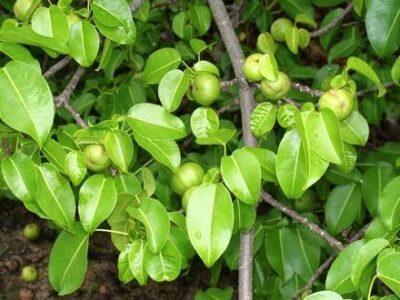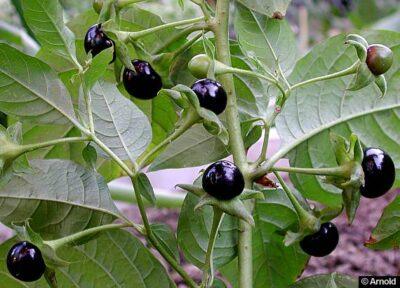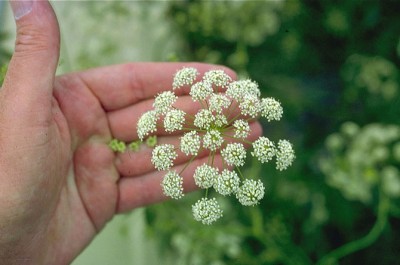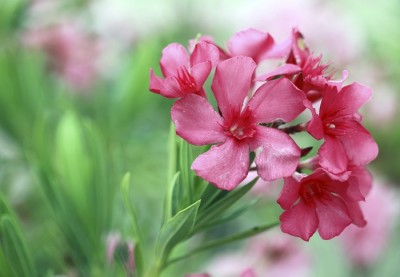Throughout the centuries, plants have developed many defense mechanisms to protect themselves from foraging animals. Some of them prove to be a skin irritant when touched, as in the case of nettles and poison ivy. Others cause severe reactions and even death on ingestion.
The famous Poison Garden in England’s Alnwick Garden houses about 100 of the most dangerous plants. There, they warn visitors not to not even smell the flowers. It’s not rare for some people to take this warning lightly to their regret.
One amazing feature of some poisonous plants is the selective distribution of the toxins in certain plant tissues – meaning that while some parts are toxic, others remain safe and even edible. A typical example is the national fruit of Jamaica called ackee. Ackee’s fleshy aril is edible but the seeds and other parts of the fruit are toxic.
Another surprising fact is that many dangerous plants hold the key to our health. The very toxins that can kill often have medical uses at lower doses. For example, the cardiac drug digitalin is derived from foxglove.
Here’s a selection of the most dangerous among the poisonous plants:
1. The manchineel tree (Hippomane mancinella)
Growing wild along the coast of South Florida, the Caribbean and the Bahamas, every part of this large tree from the spurge family contains a poisonous milky sap.
But the small, greenish yellow fruit – aptly called “the little apple of death” – pose the greatest danger as they not only resemble apples but smell and taste sweet as well.

Manchineel tree. Image source: mistertico.com
A single bite is said to cause swelling of the throat, vomiting, damage to the digestive tract with severe abdominal pain and potentially death. The Florida Institute of Food and Agricultural Sciences warns that “interaction with and ingestion of any part of this tree may be lethal.”
The milky sap of the tree was used by native Caribbean people to poison their arrow tips. One famous victim of their lethal arrows was Juan Ponce de Leon, the 16th century Spanish conquistador, who reportedly succumbed to his wounds soon after. Casual contact with the sap causes acute dermatitis and rashes that last several days to weeks. Even the smoke from burning the branches can cause painful temporary blindness and severe respiratory distress.
This tree is now on the endangered list probably due to active efforts at eradication. Many of the remaining specimens carry signs that warn people not to touch or sit under the tree as a drop of rain or dew from the leaves can burn the skin and cause severe blistering.
2. Castor bean plant – (Ricinus communis)
Castor bean plants grow wild in tropical areas, but the beautiful habit of this large shrub with striking palmate leaves has made it a welcome addition to many a garden. All parts of the plant contain the highly toxic substance known as ricin, which can kill an adult with a dose under two milligrams when ingested in the pure form.
The Secret To Starting Fires In Even The Most Extreme Conditions [2]
This toxin disrupts protein synthesis at the cellular level. The seeds are the most potent, with just a few capable of giving a lethal dose. Fortunately, the hard seed coat prevents many fatalities.
Castor oil extracted from the seeds is relatively free of ricin, but contains an alkaloid, ricinine, which irritates the digestive-tract lining when ingested. This property has been therapeutically used in indigenous medical practices as a vermifuge. The oil induces severe diarrhea that effectively gets rid of intestinal parasites and facilitates detoxing.
Castor oil is safe for external application and is widely used in cosmetics and as carrier oil for essential oils. But the oil cake left over after the extraction of oil contains lethal amounts of ricin and is known to fatally poison livestock.
3. Deadly Nightshade (Atropa belladonna)

Deadly nightshade. Image source: awl.ch
This herbaceous shrub belongs to the plant family Solanaceae, which also includes potatoes, tomatoes and eggplants. But the shiny black berries of the deadly nightshade can kill you. Children often become accidental victims because of the sweet taste of these berries. The plant is aptly named after Atropas, one of the three Greek fates responsible for cutting the thread of life of humans.
Belladonna literally means “beautiful lady.” But this title comes not from the attractiveness of the plant but from its once popular use for beautifying the eyes.
The atropine derived from the plant can dilate pupils, which was deemed an attractive look for women. It also can increase heart rate and can be fatal in higher doses. Another toxic component is scopolamine, which commonly occurs in most plants of the nightshade family.
4. Rosary Pea (Abrus precatorius)
This is a mostly inconspicuous twining vine growing wild in tropical areas. However, it has strikingly red seeds with a single black spot that are pretty enough to capture anyone’s attention, resulting in accidental poisonings and the occasional fatality, particularly among children. The tiny, perfectly oval seeds are used in jewelry-making and many artisans engaged in this trade have reportedly died of accidental needle pricks.
The seeds contain a highly toxic substance called abrin. Abrin is as potent as ricin, if not more. It disrupts protein synthesis, acts more quickly than ricin and the fatal dose for adults is less than one milligram.
Here again, nature has packed away the poison in a hard seed coat. Without that, the seeds could have caused many more fatalities. Poisoning occurs when the seed coat is damaged by chewing or crushing. Nausea and vomiting are the first symptoms on ingestion. Death from liver failure usually occurs within a week.
5. Deadly Water Hemlock (Cicuta maculata)
This North American native of the carrot family is an herbaceous plant that carries clusters of white flowers resembling Queen Anne’s lace. Even though all parts of the plant contain cicutoxin, which affects the central nervous system, the fleshy roots have the highest concentration of this substance, particularly in spring.
Ultra-Efficient Water Filter Fits In Your Pocket! [3]

Deadly water hemlock. Image source: Britannica
Cattle are the most frequently affected, hence these plants are popularly known as cowbane. Cows usually eat the leaves and stems without incident, but get poisoned when they accidentally pull the whole plant from the soft ground in spring and ingest it, root and all. Poisoning in humans mainly occurs when the roots are mistaken for water parsnips, which have similar growth habit and share the same habitat near streams and lakes.
Tremors, nausea, vomiting and confusion are the initial symptoms and they usually occur within minutes of ingesting the roots. Seizures follow as the brain gets inflamed. Kidney failure and cardiovascular problems occur, resulting in death in as little as 15 minutes, in some cases. This makes this plant one of the most dangerous in North America.
6. White Snakeroot (Ageratina altissima)
This is another white-flowered North American native notorious for causing thousands of fatalities among the European settlers of the American prairies in the 19th century, including the mother of Abraham Lincoln. The poisoning occurred indirectly through the consumption of contaminated milk from cattle grazing on these toxic plants, and was widely known as “milk sickness.”
The plant got its common name because the natives used the root for treating snake bites. They also were aware of the toxic effects of these plants, but it took the European settlers nearly a century to figure out the real cause of milk sickness.
An alcoholic compound called tremetol is responsible for the toxic effects that produce nausea, loss of appetite, red tongue, general weakness, acidosis and finally death.
Modern dairy production and distribution methods have virtually made milk sickness a thing of the past, but homesteaders who consume dairy products from individual animals reared on open pastures run the risk of poisoning.
7. Oleander (Nerium oleander)
It is hard to believe that this beautiful shrub with leaves resembling olive leaves and mildly fragrant flowers in different shades of pink, orange and white is highly poisonous. The plant enjoys a wide distribution around the world as it is tolerant of drought and frost, poor soil and neglect.
All parts of the plant are highly toxic as they contain cardiac glycosides oleandrin and oleandrigenin. Ingesting a leaf or two can result in death, but fatalities are rare because the plant materials are not palatable.
However, the risk of accidental poisoning through inhalation of the smoke from burning plant parts cannot be ignored. It can induce hallucinations at lower doses and death from overexposure.
Oleander is planted on such a large scale along the freeways of California and Texas that there’s enough plant material available to kill off the entire human race on earth and some to spare.
Although the majority of plants are safe to touch, smell and even eat, it is wise to be aware of those that are dangerous. If you have any of these plants in areas close to your home, be sure to educate family members about their danger and always watch your pets and livestock to be sure they are not munching on something that could harm them.
Are there any plants you would add to this list? Share your suggestions in the section below:
Could You ‘Live Off The Land’ With Your Gun If Necessary? Read More Here. [4]
